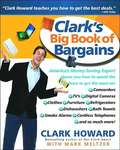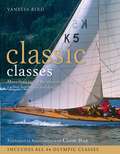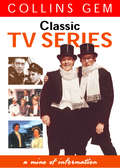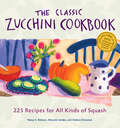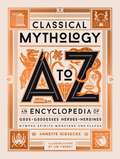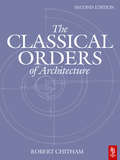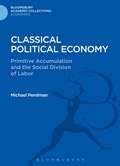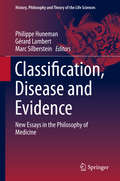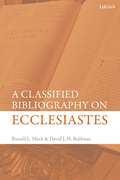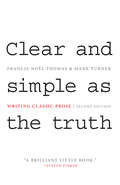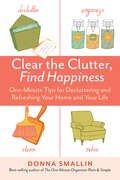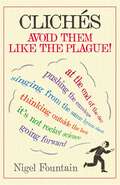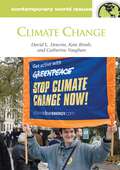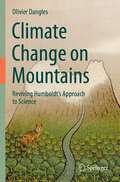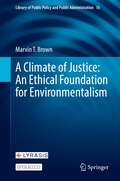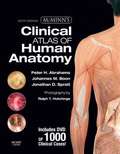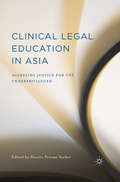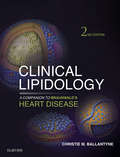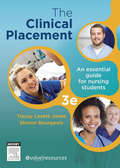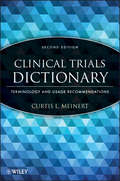- Table View
- List View
Clark's Big Book of Bargains: Clark Howard Teaches You How to Get the Best Deals
by Clark Howard Mark MeltzerClark Howard, the bestselling author of Get Clark Smart and host of the nationally syndicated radio program The Clark Howard Show, wants to show you how to get the best bang for your buck--whether you are at the supermarket, buying new clothes, renovating your home, or going to the movies. Learn how to pay $12.95 for a CD that costs $19.95. Find out why a $90 VCR just may work better than a $300 VCR.
Clark's Big Book of Bargains: Clark Howard Teaches You How to Get the Best Deals
by Clark Howard Mark MeltzerClark Howard, the bestselling author of Get Clark Smart and host of the nationally syndicated radio program The Clark Howard Show, wants to show you how to get the best bang for your buck--whether you are at the supermarket, buying new clothes, renovating your home, or going to the movies. Learn how to pay $12.95 for a CD that costs $19.95. Find out why a $90 VCR just may work better than a $300 VCR.
Classic Classes: More Than 140 Of The Most Enduring Yachts, Keelboats And Dinghies
by Vanessa BirdThis is the complete reference to the classic yachts and dinghies still sailing today. Focusing on the most well-known, popular and enduring designs - from the 7ft Optimist to the 125ft J class - this beautifully illustrated book showcases 144 boats from across the world, with a wealth of detail on each class, including: the origins and history of the class; what it's like to sail one; fascinating stories about the boat, who sailed her, and her development; stunning photography, sailplans and sail symbol; full detail on her length, layout and designer.Featuring designers from an internationally recognised hall of fame (including William Fife, Olin Stevens, Maurice Griffiths and Uffa Fox), Classic Classes is the perfect resource for classic boat owners and enthusiasts worldwide, whether their interest lies in high-performance thoroughbred racers, well-loved creek crawling cruisers or popular home-built classic dinghies. Published in advance of the 2012 Olympics, there is also a section devoted to the 46 Olympic classes.
Classic TV Series (Collins Gem)
by CollinsWhat are the best television series ever made and what do you know about them? Gem Classic TV Series introduces you to a selection of around 80 series, providing key facts, critics’ comments, quotations and trivia questions.
The Classic Zucchini Cookbook: 225 Recipes for All Kinds of Squash
by Nancy C. Ralston Marynor Jordan Andrea ChesmanFrom standards like zucchini and pumpkins to more exotic chayotes, hubbards, and turbans, The Classic Zucchini Cookbook showcases the range of flavors and versatile uses of the squash family. With 225 recipes that include Zucchini Cheddar Biscuits, Spaghetti Squash with Chicken, Caramelized Pumpkin Custard, and more, you&’ll be inspired to add squash to your breakfasts, lunches, dinners, and desserts. Seasonal suggestions, charming anecdotes, and tasty tips enliven this fun guide to squash-based cooking that is sure to have the whole family asking for more.
Classical Mythology A to Z: An Encyclopedia of Gods & Goddesses, Heroes & Heroines, Nymphs, Spirits, Monsters, and Places
by Annette GieseckeAn encyclopedic A-to-Z guide, this beautifully illustrated volume offers hundreds of rich, fascinating definitions of 700 major and minor characters, creatures, and places of classical mythology. Classical Mythology A-to-Z is a comprehensive and engrossing guide to Greek and Roman mythology. Written by Annette Giesecke, PhD, Professor of Classics and Chair of Ancient Greek and Roman Studies at the University of Delaware, this brilliant reference offers clear explanations of every character and locale, and captures the essence of these timeless tales.From the gods and goddesses of Mount Olympus and the heroes of the Trojan War to the nymphs, monsters, and other mythical creatures that populate these ancient stories, Giesecke recounts, with clarity and energy, the details of more than 700 characters and places. Each definition includes cross-references to related characters, locations, and myths, as well their equivalent in Roman mythology and cult.In addition to being an important standalone work, Classical Mythology A-to-Z is also written, designed, and illustrated to serve as an essential companion to the bestselling illustrated 75th-anniversary edition of Mythology by Edith Hamilton, including 10 full-color plates and 2-color illustrations throughout by artist Jim Tierney.
The Classical Orders of Architecture
by Robert ChithamThis is the only publication that presents a modern interpretation of the Classical Orders. The new edition of this successful title now includes the proportions in both metric and imperial measurements to make the orders more accessible and to provide a valuable reference for designers.The inclusion of both 100-part and 96-part systems of proportion is underpinned by an essay on James Gibbs - one of the 18th century authors of standardized proportioning systems - and his influence in America. Along with additional plates, this book gives aclear introduction to those not familiar with the classical genre and is an easy to follow guide which assists architects, interior designers and conservators with the quality of their design.
The Classical Orders of Architecture
by Robert ChithamThis is the only publication that presents a modern interpretation of the Classical Orders. The new edition of this successful title now includes the proportions in both metric and imperial measurements to make the orders more accessible and to provide a valuable reference for designers.The inclusion of both 100-part and 96-part systems of proportion is underpinned by an essay on James Gibbs - one of the 18th century authors of standardized proportioning systems - and his influence in America. Along with additional plates, this book gives aclear introduction to those not familiar with the classical genre and is an easy to follow guide which assists architects, interior designers and conservators with the quality of their design.
Classical Political Economy: Primitive Accumulation and the Social Division of Labor (Bloomsbury Academic Collections: Economics)
by Michael PerelmanClassical Political Economy addresses the question of what determines the social division of labour, the division of society into independent firms and industries and develops the theoretical implications of primitive accumulation. It also offers a significantly different interpretation of classical political economy, demonstrating that this school of thought supported the process of primitive accumulation.Classical political economy presents an imposing facade. For more than two centuries, the accepted doctrine dictates that a market generates forces that provide the most efficient method for organising production. This laissez faire approach is an ideology that gives capital absolute freedom of action, and yet called for intervention to coerce people to do things that they would not otherwise do. Classical political economy therefore encouraged policies that would hinder people's ability to produce for their own needs.Michael Perelman, however, in this innovative take on the subject, seeks to challenge the ideologies that would allow things to continue in this line unchecked.
Classification, Disease and Evidence: New Essays in the Philosophy of Medicine (History, Philosophy and Theory of the Life Sciences #7)
by Philippe Huneman Gérard Lambert Marc SilbersteinThis anthology of essays presents a sample of studies from recent philosophy of medicine addressing issues which attempt to answer very general (interdependent) questions: (a) what is a disease and what is health? (b) How do we (causally) explain diseases? (c) And how do we distinguish diseases, i.e. define classes of diseases and recognize that an instance X of disease belongs to a given class B? (d) How do we assess and choose cure/ therapy?The book is divided into three sections: classification, disease and evidence. In general, attention is focused on statistics in medicine and epidemiology, issues in psychiatry and connecting medicine with evolutionary biology and genetics. Many authors position the theories that they address within their historical contexts.The nature of health and disease will be addressed in several essays that also touch upon very general questions about the definition of medicine and its status. Several chapters scrutinize classification because of its centrality within philosophical problems raised by medicine and its core position in the philosophical questioning of psychiatry. Specificities of medical explanation have recently come under a new light, particularly because of the rise of statistical methods and several chapters investigate these methods in specific contexts such as epidemiology or meta-analysis of random testing. Taken together this collection addresses the question of how we gather, use and assess evidence for various medical theories.The rich assortment of disciplines featured also includes epidemiology, parasitology and public health, while technical aspects such as the application of game theory to medical research and the misuse of the DSM in forensic psychiatry are also given an airing. The book addresses more than the construction of medical knowledge, however, adding cogent appraisal of the processes of decision making in medicine and the protocols used to justify therapeutic choices.
Classified Bibliography on Ecclesiastes
by David J. Beldman Russell L. MeekThis volume is a comprehensive listing of bibliographical references to writings on the book of Ecclesiastes, beginning from 1900. Rather than being presented in alphabetical order, these references are classified according to genre, chapter, subject and theme; among the myriad of classifications are biblical theology, commentaries, death and the afterlife, God/the divine, joy, language, sexuality, structure and wisdom.These classifications have been selected by specialists of Ecclesiastes, in order to guide scholars and researchers through the wealth of secondary material available and to prompt further research on the text. Through its collation of the incredible amount of bibliographical data on the book of Ecclesiastes, this collection will prove a vital resource for those working on Ecclesiastes for years to come.
Classified Bibliography on Ecclesiastes
by David J. Beldman Russell L. MeekThis volume is a comprehensive listing of bibliographical references to writings on the book of Ecclesiastes, beginning from 1900. Rather than being presented in alphabetical order, these references are classified according to genre, chapter, subject and theme; among the myriad of classifications are biblical theology, commentaries, death and the afterlife, God/the divine, joy, language, sexuality, structure and wisdom.These classifications have been selected by specialists of Ecclesiastes, in order to guide scholars and researchers through the wealth of secondary material available and to prompt further research on the text. Through its collation of the incredible amount of bibliographical data on the book of Ecclesiastes, this collection will prove a vital resource for those working on Ecclesiastes for years to come.
Clear and Simple as the Truth: Writing Classic Prose, Second Edition
by Francis-Noël Thomas Mark TurnerFor more than a decade, Clear and Simple as the Truth has guided readers to consider style not as an elegant accessory of effective prose but as its very heart. Francis-Noël Thomas and Mark Turner present writing as an intellectual activity, not a passive application of verbal skills. In classic style, the motive is truth, the purpose is presentation, the reader and writer are intellectual equals, and the occasion is informal. This general style of presentation is at home everywhere, from business memos to personal letters and from magazine articles to student essays. Everyone talks about style, but no one explains it. The authors of this book do; and in doing so, they provoke the reader to consider style, not as an elegant accessory of effective prose, but as its very heart. At a time when writing skills have virtually disappeared, what can be done? If only people learned the principles of verbal correctness, the essential rules, wouldn't good prose simply fall into place? Thomas and Turner say no. Attending to rules of grammar, sense, and sentence structure will no more lead to effective prose than knowing the mechanics of a golf swing will lead to a hole-in-one. Furthermore, ten-step programs to better writing exacerbate the problem by failing to recognize, as Thomas and Turner point out, that there are many styles with different standards. The book is divided into four parts. The first, "Principles of Classic Style," defines the style and contrasts it with a number of others. "The Museum" is a guided tour through examples of writing, both exquisite and execrable. "The Studio," new to this edition, presents a series of structured exercises. Finally, "Further Readings in Classic Prose" offers a list of additional examples drawn from a range of times, places, and subjects. A companion website, classicprose.com, offers supplementary examples, exhibits, and commentary, and features a selection of pieces written by students in courses that used Clear and Simple as the Truth as a textbook.
Clear and Simple as the Truth: Writing Classic Prose, Second Edition (PDF)
by Francis-Noël Thomas Mark TurnerFor more than a decade, Clear and Simple as the Truth has guided readers to consider style not as an elegant accessory of effective prose but as its very heart. Francis-Noël Thomas and Mark Turner present writing as an intellectual activity, not a passive application of verbal skills. In classic style, the motive is truth, the purpose is presentation, the reader and writer are intellectual equals, and the occasion is informal. This general style of presentation is at home everywhere, from business memos to personal letters and from magazine articles to student essays. Everyone talks about style, but no one explains it. The authors of this book do; and in doing so, they provoke the reader to consider style, not as an elegant accessory of effective prose, but as its very heart. At a time when writing skills have virtually disappeared, what can be done? If only people learned the principles of verbal correctness, the essential rules, wouldn't good prose simply fall into place? Thomas and Turner say no. Attending to rules of grammar, sense, and sentence structure will no more lead to effective prose than knowing the mechanics of a golf swing will lead to a hole-in-one. Furthermore, ten-step programs to better writing exacerbate the problem by failing to recognize, as Thomas and Turner point out, that there are many styles with different standards. The book is divided into four parts. The first, "Principles of Classic Style," defines the style and contrasts it with a number of others. "The Museum" is a guided tour through examples of writing, both exquisite and execrable. "The Studio," new to this edition, presents a series of structured exercises. Finally, "Further Readings in Classic Prose" offers a list of additional examples drawn from a range of times, places, and subjects. A companion website, classicprose.com, offers supplementary examples, exhibits, and commentary, and features a selection of pieces written by students in courses that used Clear and Simple as the Truth as a textbook.
Clear the Clutter, Find Happiness: One-Minute Tips for Decluttering and Refreshing Your Home and Your Life
by Donna SmallinClear the Clutter offers practical ways to clean and organize that you can accomplish in just a few minutes at a time.
Clichés: Avoid Them Like The Plague
by Nigel FountainAt the end of the day, when it comes to getting your head around clichés, everybody seems to be singing from the same hymn sheet. Clichés have become such a familiar part of the English language and people's everyday speech that many are now trite, meaningless and often quite irritating. This book looks at clichés in their many forms - once useful but overworked catch phrases ('move the goal posts'), worn-out sayings ('all hands on deck'), pointless phrases used to conceal a weak argument ('to be perfectly honest'), technical terms used out of context ('collateral damage'), and many others. It shows where they came from and, with examples from people who ought to know better, why they should be avoided. Entertaining and informative, this collection of clichés really is the best thing since sliced bread . . .
Climate Change: A Reference Handbook (Contemporary World Issues)
by David Downie Kate Brash Catherine VaughanAn accessible introduction to climate change that outlines key scientific, economic, and political issues, reviews how the global community has addressed the issue to date, and discusses the options being explored for further action.Climate Change: A Reference Handbook offers readers a way to separate science from politics on this crucial and often contentious issue. It provides a comprehensive introduction to the science and public policy of climate change, including discussion of historical developments, today's key concepts, and the future of climate science and policy.Climate Change begins by explaining the science behind global climate change, including the growing consensus that human activity is a major contributing factor. It then takes an objective look at the key conflicts in climate science and policy, describes those that have been resolved, and offers a balanced review of proposals for those that have not. A separate chapter focuses on the scientific, economic, and political aspects of climate change as they are playing out specifically in the United States.
Climate Change on Mountains: Reviving Humboldt’s Approach to Science
by Olivier DanglesThe world is warming up rapidly and this change is most noticeable in mountains with already observable consequences on flora and fauna. This book presents concepts, methodologies and major achievements of recent research in climate change ecology in mountains by placing this research in a historical perspective, that of travelers and naturalists of the Romantic era, and first of all Alexander von Humboldt.There is now a renewed interest, both in academia and beyond, in Humboldt, his writings and his view of nature. But how can we actually make use of his writings? How can we put his philosophy into practice? How can we still learn from past scientific figures and do a better science today? In this book, the author presents how it is possible to succeed in modern science by returning to sources, by renewing the tradition of past polymaths such as Humboldt, and by having a fully humanistic approach in science. He illustrates his point based on his 15-year experience in the study of the ecological effects of climate change in the tropical Andes, showing how he has incorporated approaches from other disciplines, from different branches of science, from history and the arts to achieve a more comprehensive view of his scientific field. Alongside hard data, discoveries by past naturalists build our understanding of the world but appealing to our emotions makes us want to understand it. In the author’s view this is a productive and enjoyable way of doing science that speaks to our humanity and also increases our knowledge about nature. This academic cross-over book appeals to a broad audience of students, scientists or, supported by attractive illustrations, to anyone interested in the adventure or making of science, but not necessarily with a scientific background.
A Climate of Justice: An Ethical Foundation for Environmentalism (Library of Public Policy and Public Administration #16)
by Marvin T. BrownThis open access book helps readers combine history, politics, and ethics to address the most pressing problem facing the world today: environmental survival. In A Climate of Justice, Marvin Brown connects the environmental crisis to basic questions of economic, social, and racial justice. Brown shows how our current social climate maintains systemic injustices, and he uncovers resources for change through a civic ethics of repair and reciprocity. A must-read for researchers and educators in the area of environmental ethics and those teaching courses in the fields of public policy and environmental sustainability. With the support of more than 30 libraries, the LYRASIS United Nations Sustainable Development Goals Fund has enabled this publication related to SDG13 (Climate Action) to be available fully open access.
Clinical Atlas Of Human Anatomy (PDF)
by Peter H. Abrahams Jonathan D. Spratt Johannes M. Boon Ralph T. HutchingsMap out all of the key structures of the human body with examples of real human dissections. . . and easily place them in a clinical context! This popular atlas incorporates an unrivalled collection of cadaveric, osteological, and clinical images with surface anatomy models, interpretive drawings, orientational diagrams, and diagnostic images - emphasizing a well-rounded visual perspective of a real human body as seen by modern doctors. The 6th Edition offers new endoscopic images, 250 new dissection photos (including eight pages of new dissections on lymphatics), and 300 new clinical thumbnails. A bonus DVD - new to this edition - includes 1,000 additional photos not found in the text, as well as questions and answers that accompany each section from the book. Displays X-ray, MR, and CT images next to corresponding dissections, showing how to recognize anatomic structures in diagnostic images. Presents interpretive drawings to help you differentiate between structures with a similar appearance (i. e. , veins, arteries, and nerves). Offers orientational diagrams that make it easier to relate the dissections in the text to real experiences in the lab. Provides an unobstructed view of the artwork by using a numbered labeling system, which also allows you to self-test by covering up the key and identifying each numbered structure yourself. Presents 300 new clinical thumbnails - with relevant clinical notes and additional images on the DVD - that emphasize the clinical relevance of images depicted and demonstrate their clinical relevance. Offers 250 new dissection photos that enhance the overall quality and scope of the images shown #65533; eight pages of new dissections on lymphatics #65533; 50 new illustrations reflecting the increasing use of diagnostic imaging in anatomy teaching #65533; and 20 new endoscopic images to reinforce memorization of structures. Features a bonus DVD with 1,000 clinical photos not found in the text. . . more information on clinical correlations. . . and questions and answers that accompany each section of the book.
Clinical Legal Education in Asia: Accessing Justice for the Underprivileged
by Shuvro Prosun SarkerThis book describes the history, present status and possible future models of clinical legal education (CLE) in 12 Asian countries, with particular focus on the Asian character of CLE as it has evolved in different countries.
Clinical Lipidology: Expert Consult: Online And Print (Companion to Braunwald's Heart Disease)
by Christie M. BallantyneClinical Lipidology, a companion to Braunwald’s Heart Disease, is designed to guide you through the ever-changing therapeutic management of patients with high cholesterol levels. From basic science to pathogenesis of atherothrombotic disease, to risk assessment and the latest therapy options, this medical reference book offers unparalleled coverage and expert guidance on lipidology in a straightforward, accessible, and user-friendly style.Get authoritative guidance from some of the foremost experts in the field.Easily access key content with help from treatment algorithms.Access options and evidence-based solutions for every type of patient scenario, as well as the latest clinical guidelines and clinically relevant evidence on risk assessment, special patient populations, and therapy, including recently approved and experimental therapies.Remain at the forefront of the cardiology field with up-to-date chapters on treatment guidelines; diet, exercise, and weight loss; pharmacologic therapies such as statins, omega-3 fatty acids, and combination therapy; evolving targets of therapy such as PCSK9 inhibition, CETP inhibition, and inflammationPrepare for special patient populations such as children and adolescents; women and the elderly; transplant recipients; HIV patients; and those with chronic renal disease, familial hypercholesterolemia, other severe hypercholesterolemias, diabetes, or other metabolic syndromes.Take advantage of a format that follows that of the well-known and internationally recognized Braunwald’s Heart Disease.Consult this title on your favorite e-reader, conduct rapid searches, and adjust font sizes for optimal readability.
The Clinical Placement - E-Book: An Essential Guide for Nursing Students
by Tracy Levett-Jones Sharon BourgeoisPerfect for: Bachelor of Nursing studentsDiploma of Nursing students An essential resource to prepare nursing students for their clinical placements and gain the most from their experiences. With a focus on expectations and how to think, act, feel and communicate within complex clinical environments, Clinical Placement: An essential guide for nursing students, 3rd Edition provides tips for maximising learning opportunities and practical strategies for dealing with difficult and challenging situations. Evolve Resources: The Clinical Placement, 3rd Edition is supported by an engaging series of video interviews with nurses from a diverse range of clinical practice areas. Each nurse shares insights, advice, highlights challenges and opportunities, and assists with tips for clinical placement. Evolve resources include: o 12 video interviews with nurses from a range of clinical practice areas o ‘Need to know’ quick tips o ‘Challenges you may encounter’Other key features within the chapters include: Something to Think About, Student Experience case studies and Coaching Tips.Greater emphasis on cultural sensitivity, simulation as preparation for practice, patient safety, inter-professional communication and professional portfolio developmentCoaching Tips – advice on common issuesSomething to Think About – encourages students to relate theory to their own practice.
Clinical Trials Dictionary: Terminology and Usage Recommendations
by Curtis L. MeinertA thoroughly updated new edition of the essential reference on the design, practice, and analysis of clinical trials Clinical Trials Dictionary: Terminology and Usage Recommendations, Second Edition presents clear, precise, meticulously detailed entries on all aspects of modern-day clinical trials. Written and compiled by one of the world’s leading clinical trialists, this comprehensive volume incorporates areas of medicine, statistics, epidemiology, computer science, and bioethics—providing a treasure trove of key terms and ideas. This new edition continues to supply readers with the A–Z terminology needed to design, conduct, and analyze trials, introducing a vocabulary for the characterization and description of related features and activities. More than 300 new entries are now included, reflecting the current usage practices and conventions in the field, along with usage notes with recommendations on when to use the term in question. Detailed biographical notes highlight prominent historical figures and institutions in the field, and an extensive bibliography has been updated to provide readers with additional resources for further study. The most up-to-date work of its kind, Clinical Trials Dictionary, Second Edition is an essential reference for anyone who needs to report on, index, analyze, or assess the scientific strength and validity of clinical trials.
Clinical Trials Dictionary: Terminology and Usage Recommendations
by Curtis L. MeinertA thoroughly updated new edition of the essential reference on the design, practice, and analysis of clinical trials Clinical Trials Dictionary: Terminology and Usage Recommendations, Second Edition presents clear, precise, meticulously detailed entries on all aspects of modern-day clinical trials. Written and compiled by one of the world’s leading clinical trialists, this comprehensive volume incorporates areas of medicine, statistics, epidemiology, computer science, and bioethics—providing a treasure trove of key terms and ideas. This new edition continues to supply readers with the A–Z terminology needed to design, conduct, and analyze trials, introducing a vocabulary for the characterization and description of related features and activities. More than 300 new entries are now included, reflecting the current usage practices and conventions in the field, along with usage notes with recommendations on when to use the term in question. Detailed biographical notes highlight prominent historical figures and institutions in the field, and an extensive bibliography has been updated to provide readers with additional resources for further study. The most up-to-date work of its kind, Clinical Trials Dictionary, Second Edition is an essential reference for anyone who needs to report on, index, analyze, or assess the scientific strength and validity of clinical trials.
